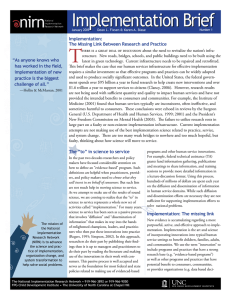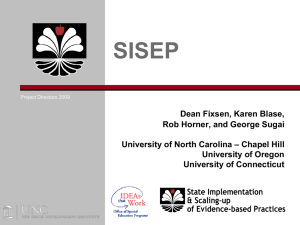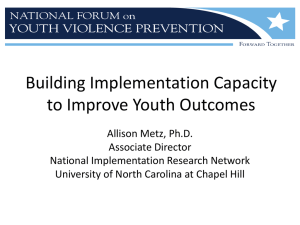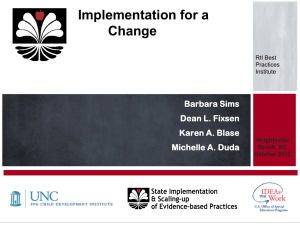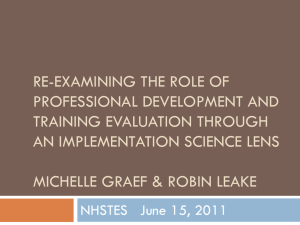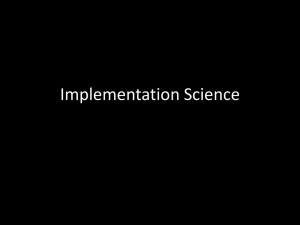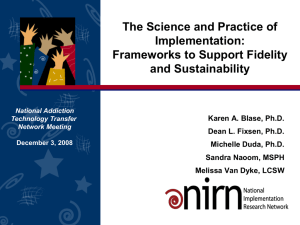Stage-Based Measures of Implementation Components
advertisement
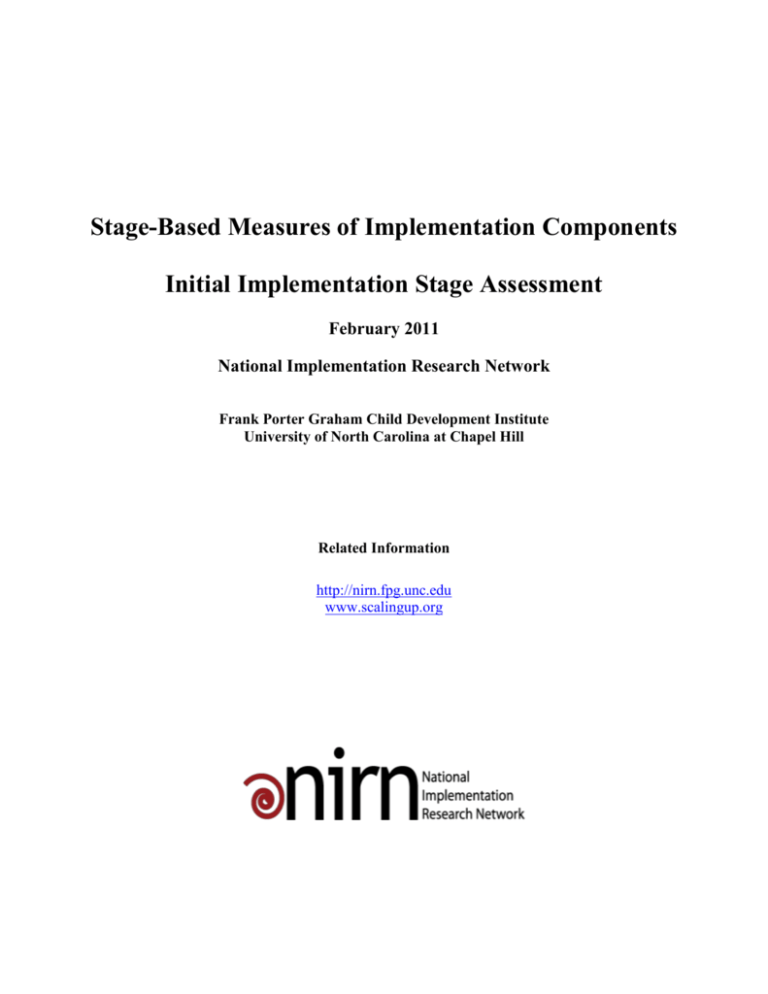
Stage-Based Measures of Implementation Components Initial Implementation Stage Assessment February 2011 National Implementation Research Network Frank Porter Graham Child Development Institute University of North Carolina at Chapel Hill Related Information http://nirn.fpg.unc.edu www.scalingup.org Stage-Based Measures of Implementation Components Initial Implementation Stage Assessment February 2011 National Implementation Research Network With the identification of theoretical frameworks resulting from a synthesis of the implementation evaluation literature, there has been a need for measures of the implementation components to assess implementation progress and to test the hypothesized relationships among the components. Reliable and valid measures of implementation components are essential to planning effective implementation supports, assessing progress toward implementation capacity, and conducting rigorous research on implementation. Policy, practice, and science related to implementation can be advanced more rapidly with practical ways to assess implementation. Since the beginnings of the field, the difficulties inherent in implementation have "discouraged detailed study of the process of implementation. The problems of implementation are overwhelmingly complex and scholars have frequently been deterred by methodological considerations. ... a comprehensive analysis of implementation requires that attention be given to multiple actions over an extended period of time" (Van Meter & Van Horn, 1975, p. 450 - 451; see a similar discussion nearly three decades later by Greenhalgh, Robert, MacFarlane, Bate, & Kyriakidou, 2004). Adding to this complexity is the need to simultaneously and practically measure a variety of variables over time, especially when the implementation variables under consideration are not well researched. Recent reviews of the field (Ellis, Robinson, Ciliska, Armour, Raina, Brouwers, et al., 2003; Greenhalgh et al., 2004) have concluded that the wide variation in methodology, measures, and use of terminology across studies limits interpretation and prevents meta-analyses with regard to dissemination-diffusion and implementation studies. Recent attempts to analyze components of implementation have used 1) very general measures (e.g. Landenberger & Lipsey, 2005; Mihalic & Irwin, 2003) that do not specifically address core implementation components, 2) measures specific to a given innovation (e.g. Olds, Hill, O'Brien, Racine, & Moritz, 2003; Schoenwald, Sheidow, & Letourneau, 2004) that may lack generality across programs, or 3) measures that only indirectly assess the influences of some of the core implementation components (e.g. Klein, Conn, Smith, Speer, & Sorra, 2001; Panzano, et al., 2004). The following assessments are specific to “best practices” extracted from: 1) the literature, 2) interactions with purveyors who are successfully implementing evidence-based programs on a national scale, 3) in-depth interviews with 64 evidence-based program developers, 4) metaanalyses of the literature on leadership, and 5) analyses of leadership in education (Blase, Fixsen, Naoom, & Wallace, 2005; Fixsen, Naoom, Blase, Friedman, & Wallace, 2005; Heifetz & Laurie, 1997; Kaiser, Hogan, & Craig, 2008; Naoom, Blase, Fixsen, Van Dyke, & Bailey, 2010; Rhim, Kowal, Hassel, & Hassel, 2007). © Dean L. Fixsen and Karen A. Blase, National Implementation Research Network Page 2 For more information on the frameworks for Implementation Drivers and Implementation Stages derived by the National Implementation Research Network, go to http://nirn.fpg.unc.edu. The synthesis of the implementation evaluation literature can be downloaded from the NIRN website. You have our permission to use these measures in any non-commercial way to advance the science and practice of implementation, organization change, and system transformation. Please let us know how you are using the measures and let us know what you find so we can all learn together. As you use these measures, we encourage you to do cognitive interviewing of key informants to help revise the wording of the items to help ensure each item taps the desired aspect of each implementation component. We ask that you let us know how you use these items so we can use your experience and data to improve and expand the survey. Please respond to Dean Fixsen (contact information below). Thank you. Dean L. Fixsen, Ph.D. Senior Scientist FPG Child Development Institute CB 8040 University of North Carolina at Chapel Hill Chapel Hill, NC 27599-8040 Cell # 727-409-1931 Reception 919-962-2001 Fax 919-966-7463 References Blase, K. A., Fixsen, D. L., Naoom, S. F., & Wallace, F. (2005). Operationalizing implementation: Strategies and methods. Tampa, FL: University of South Florida, Louis de la Parte Florida Mental Health Institute. http://nirn.fmhi.usf.edu/resources/detail.cfm?resourceID=48 Ellis, P., Robinson, P., Ciliska, D., Armour, T., Raina, P., Brouwers, M., et al. (2003). Diffusion and Dissemination of Evidence-Based Cancer Control Interventions. (No. Evidence Report /Technology Asessment Number 79. (Prepared by Oregon Health and Science University under Contract No. 290-97-0017.) AHRQ Publication No. 03-E033. Rockville, MD: Agency for Healthcare Research and Quality. Fixsen, D. L., Naoom, S. F., Blase, K. A., Friedman, R. M., & Wallace, F. (2005). Implementation Research: A synthesis of the literature. Tampa, FL: University of South Florida, Louis de la Parte Florida Mental Health Institute, The National Implementation Research Network (FMHI Publication #231). http://nirn.fmhi.usf.edu/resources/detail.cfm?resourceID=31 Greenhalgh, T., Robert, G., MacFarlane, F., Bate, P., & Kyriakidou, O. (2004). Diffusion of innovations in service organizations: Systematic review and recommendations. The Milbank Quarterly, 82(4), 581-629. Heifetz, R. A., & Laurie, D. L. (1997). The work of leadership. Harvard Business Review, 75(1), 124134. Kaiser, R. B., Hogan, R., & Craig, S. B. (2008). Leadership and the fate of organizations. American Psychologist, 63(2), 96-110. © Dean L. Fixsen and Karen A. Blase, National Implementation Research Network Page 3 Klein, K. J., & Sorra, J. S. (1996). The challenge of innovation implementation. Academy of Management Review, 21(4), 1055-1080. Klein, K. J., Conn, B., Smith, A., Speer, D. B., & Sorra, J. (2001). Implementing computerized technology: An organizational analysis. Journal of Applied Psychology, 86(5), 811-824. Landenberger, N. A., & Lipsey, M. W. (2005). The Positive Effects of Cognitive-Behavioral Programs for Offenders: A Meta-Analysis of Factors Associated with Effective Treatment. Journal of Experimental Criminology, 1(4), 451-476. Mihalic, S., & Irwin, K. (2003). Blueprints for Violence Prevention: From Research to Real-World Settings-Factors Influencing the Successful Replication of Model Programs. Youth Violence and Juvenile Justice, 1(4), 307-329. Naoom, S. F., Blase, K., Fixsen, D. L., Van Dyke, M., & Bailey, F. W. (2010). Implementing EvidenceBased Programs in the Real World: Lessons Learned from Model Program Developers and Purveyors. Chapel Hill, NC: National Implementation Research Network, FPG Child Development Institute, UNC. Olds, D. L., Hill, P. L., O'Brien, R., Racine, D., & Moritz, P. (2003). Taking preventive intervention to scale: The nurse-family partnership. Cognitive and Behavioral Practice, 10, 278-290. Panzano, P. C., & Roth, D. (2006). The decision to adopt evidence-based and other innovative mental health practices: Risky business? Psychiatric Services, 57(8), 1153-1161. Panzano, P. C., Seffrin, B., Chaney-Jones, S., Roth, D., Crane-Ross, D., Massatti, R., et al. (2004). The innovation diffusion and adoption research project (IDARP). In D. Roth & W. Lutz (Eds.), New research in mental health (Vol. 16). Columbus, OH: The Ohio Department of Mental Health Office of Program Evaluation and Research. Rhim, L. M., Kowal, J. M., Hassel, B. C., & Hassel, E. A. (2007). School turnarounds: A review of the cross-sector evidence on dramatic organizational improvement. Lincoln, IL: Public Impact, Academic Development Institute. Schoenwald, S. K., Sheidow, A. J., & Letourneau, E. J. (2004). Toward Effective Quality Assurance in Evidence-Based Practice: Links Between Expert Consultation, Therapist Fidelity, and Child Outcomes. Journal of Clinical Child and Adolescent Psychology, 33(1), 94-104. Van Meter, D. S., & Van Horn, C. E. (1975). The policy implementation process: A conceptual framework. Administration & Society, 6, 445-488. © Dean L. Fixsen and Karen A. Blase, National Implementation Research Network Page 4 Stage-Based Implementation Assessments To use the stage-based assessments of implementation, the assessor first must determine the stage of implementation for the innovation in an organization. There are no fixed rules to follow, so assessors must use their good judgment. The reader is referred to the Assessment of Implementation Stages for more information and action planning. Stage of Implementation Assessments Exploration Assessment of Implementation Stages ImpleMap Installation Stage Assessment Installation Stage Action Planning Guide Initial Implementation Component Assessment Initial Implementation Action Planning Guide Full Implementation Component Assessment Implementation Tracker Installation Initial Implementation Full © Dean L. Fixsen and Karen A. Blase, National Implementation Research Network Page 5 Initial Implementation Stage Assessments of Implementation The Implementation Drivers are processes that can be leveraged to improve competence and to create a more hospitable organizational and systems environment for an evidence-based program or practice (Fixsen, Naoom, Blase, Friedman, & Wallace, 2005). Since sound and effective implementation requires change at the practice, organization, and State and Federal levels, these processes must be purposeful to create change in the knowledge, behavior, and attitudes of all the human service professionals and partners involved. A pre-requisite for effective use of the Implementation Drivers is a well operationalized, intervention, program, practice, or innovation. The more clearly the core intervention components are defined and validated through research (e.g. fidelity correlated with outcomes; dosage and outcome data), the more clearly the Implementation Drivers can be focused on bringing these core intervention components “to life” and sustaining and improving them in context of practices, organizations, and systems. The Implementation Drivers are reviewed here in terms of accountability and ‘best practices’ to improve and achieve competence and confidence of the persons who will be involved in implementing the new way of work (e.g. practitioners, supervisors, coaches, managers, directors, etc.) and the organizations and systems that will support the new ways of work. Implementation Teams, with members who know the intervention well, can use this tool as a way to discuss the roles and responsibilities with the individuals they are guiding. Engaging TA providers and program developers in this process can yield a useful and enlightening discussion that will not only impact program quality but also programmatic sustainability. Overall, the Drivers are viewed through an Implementation Lens. After all, most organizations would say that they already recruit and select staff, provide orientation and some training, supervise their staff, etc. But what do these activities look like when they are focused on Effective Implementation Practices designed to create practice, organizational, and systems change at all levels? The Team using the Installation Stage Assessment items also will want to discuss the importance and perceived cost-benefit of fully utilizing the best practices related to each Driver as well as the degree to which the Team has ‘control’ over each Driver and the associated ‘best practices’. When the best practices cannot be adhered to, then the Team needs to be confident that weaknesses in one Driver are being compensated for by robust application of other Drivers. For example, if skill-based training is needed but is not offered with qualified behavior rehearsal leaders who know the intervention well; then coaches will have increased responsibility to develop the basic skills of the persons they are coaching. © Dean L. Fixsen and Karen A. Blase, National Implementation Research Network Page 6 COMPETENCY DRIVER - Recruitment and Selection of Staff: To what extent are best practices being used? Accountability for developing recruitment and selection processes and criteria is clear (e.g. lead person designated and supported) Job description clarity re: accountability and expectations Pre-Requisites are related to “new practices” and expectations (e.g. basic group management skills) Interactive Interview Process: Behavioral vignettes and Behavior Rehearsals Assessment of ability to accept feedback Assessment of ability to change own behavior Interviewers who understand the skills and abilities needed and can assess applicants accurately. Feed forward of interview data to training staff & administrators & coaches (integration) Feedback from exit interviews, training data, turnover data, opinions of administrators & coaches, and staff evaluation data to evaluate effectiveness of this Driver Best Practice Scores - Percent of Recruitment and Selection Items in each column In Partially Not In Notes: Place In Place Place o o o o o o o o o © Dean L. Fixsen and Karen A. Blase, National Implementation Research Network Page 7 COMPETENCY DRIVER - Training: To what extent are best practices being used? Accountability for delivery and quality monitoring of training is clear (e.g. lead person designated and supported) Timely (criteria: Training occurs before the person attempts to or is required to use the new program or practice) Theory grounded (adult learning principles used) Skill-based Behavior Rehearsals vs. Role Plays Qualified Rehearsal Leaders who are Content Experts Practice to Criteria Feed Forward of pre/post data to Coaches/Supervisors Feedback of pre/post data to Selection and Recruitment Outcome data collected and analyzed (pre and post testing) of knowledge and/or skills Trainers have been trained and coached Fidelity measures collected and analyzed related to training (e.g. schedule, content, processes, qualification of trainers) Best Practice Scores - Percent of Training Items in each column In Partially Not In Notes: Place In Place Place o o o © Dean L. Fixsen and Karen A. Blase, National Implementation Research Network Page 8 COMPETENCY DRIVER - Supervision and Coaching: To what extent are best practices being used? Accountability for development and monitoring of quality and timeliness of coaching services is clear (e.g. lead person designated and supported) Written Coaching Service Delivery Plan Uses multiple sources of information for feedback Direct observation of implementation (in person, audio, video) Coaching data reviewed and informs improvements of other Drivers Accountability structure and processes for Coaches Adherence to Coaching Service Delivery Plan is regularly reviewed Multiple sources of information used for feedback to coaches o Satisfaction surveys from those being coached o Observations of expert/master coach o Fidelity measures of those being coached as key coaching outcome Best Practice Scores - Percent of Supervision/Coaching Items in each column In Partially Not In Notes: Place In Place Place © Dean L. Fixsen and Karen A. Blase, National Implementation Research Network Page 9 COMPETENCY DRIVER - Performance Assessment - Fidelity: To what extent are best practices being used? Accountability for fidelity measurement and reporting system is clear (e.g. lead person designated and supported) Transparent Processes – Proactive staff orientation to the process and procedures Fidelity measures are correlated with outcomes; are available on a regular basis and used for decisionmaking Fidelity measurement and reporting system is practical and efficient Use of Appropriate Data Sources (e.g. competency requires observation) Positive recognition processes in place for participation Fidelity data over time informs modifications to implementation drivers (e.g. how can Selection, Training, and Coaching better support high fidelity) Best Practice Scores - Average Percent of Performance Assessment/Fidelity Items in each column In Partially Not In Notes: Place In Place Place © Dean L. Fixsen and Karen A. Blase, National Implementation Research Network Page 10 ORGANIZATION DRIVER - Decision Support Data Systems: To what extent are best practices being used? Accountability for measurement and reporting system is clear (e.g. lead person designated and supported) Includes intermediate and longer-term outcome measures Includes process measures (fidelity) Measures are “socially important” (e.g. academic achievement, school safety) Data are: Reliable (standardized protocols, trained data gatherers) Reported frequently (e.g. weekly, quarterly) Built into practice routines Collected at and available to actionable units (e.g. grade level, classroom, student “unit”) Widely shared with building and District personnel Shared with family members and community Used to make decisions (e.g. curricula, training needed, coaching improvements) Best Practice Scores - Average Percent of Decision Support Data System Items in each column In Partially Not In Notes: Place In Place Place © Dean L. Fixsen and Karen A. Blase, National Implementation Research Network Page 11 ORGANIZATION DRIVER - Facilitative Administrative Supports: To what extent are best practices being used? In Place Partially Not In Notes: In Place Place A Building/District Leadership and Implementation Team is formed The Building/District Leadership and Implementation Team has Terms of Reference that include communication protocols to provide feedback to the next level “up” and describes from whom feedback is received (PEP-PIP protocol) The Team uses feedback and data to improve Implementation Drivers Policies and procedures are developed and revised to support the new ways of work Solicits and analyzes feedback from staff Solicits and analyzes feedback from “stakeholders” Reduces internal administrative barriers to quality service and high fidelity implementation Best Practice Scores - Average Percent of Facilitative Administration Items in each column © Dean L. Fixsen and Karen A. Blase, National Implementation Research Network Page 12 ORGANIZATION DRIVER - Systems Intervention To what extent are best practices being used? Building Leadership and Implementation is formed and supported by the District Leadership matches level needed to intervene Engages and nurtures multiple “champions” and “opinion leaders” Objectively documents barriers and reports barriers to next level “up” Makes constructive recommendations to next level “up” to resolve barriers Develops formal processes to establish and use PEP – PIP cycles (e.g. linking communication protocols to give and receive feedback from the next level “down” and “up”) Creates time-limited, barrier busting capacity by: Using Transformation Zones Doing usability testing (short PDSA cycles with small groups) Creates optimism and hope by communicating successes Average Percent of Systems Intervention Items in each column In Place Partially Not In Notes: In Place Place o o © Dean L. Fixsen and Karen A. Blase, National Implementation Research Network o o o o Page 13 LEADERSHIP DRIVER To what extent are best practices being used? Technical Leadership Leaders within the organization have provided specific guidance on technical issues where there was sufficient clarity about what needed to be done. Leaders within the organization have been very good at giving reasons for changes in policies, procedures, or staffing. Leaders within the organization have been actively engaged in resolving any and all issues that got in the way of using the innovation effectively. Leaders within the organization have been very good at focusing on the issues that really matter at the practice level. Leaders within the organization have been fair, respectful, considerate, and inclusive in their dealings with others. Adaptive Leadership Leaders within the organization continually have looked for ways to align practices with the overall mission, values, and philosophy of the organization. Leaders within the organization have convened groups and worked to build consensus when faced with issues on which there was little agreement about how to proceed. Leaders within the organization have established clear and frequent communication channels to provide information to practitioners and to hear about their successes and concerns. In Place Partially Not In Notes: In Place Place o o o o o o © Dean L. Fixsen and Karen A. Blase, National Implementation Research Network Page 14 Leaders within the organization have actively and routinely sought feedback from practitioners and others regarding supports for effective use of the innovation. Leaders within the organization have been actively involved in such things as conducting employment interviews, participating in practitioner training, conducting performance assessments of individual practitioners, and creating more and better organization-level assessments to inform decision making. Average Percent of Leadership Items in each column o © Dean L. Fixsen and Karen A. Blase, National Implementation Research Network o o Page 15 Quality Implementation Score Summary: Average Percent of Items Across Seven Implementation Drivers for each column Summary of “next right steps” by Driver: Recruitment and Selection: Pre-Service and In-Service Training: Supervision and Coaching: Performance Assessment - Fidelity: Decision Support Data Systems: Facilitative Administrative Supports: Systems Intervention at the Organizational Level: Leadership: Learn more about the science and practice of Implementation at: www.scalingup.org by reading the Scaling Up Briefs and more about implementation science at http://nirn.fpg.unc.edu/ Access the monograph by Fixsen, Naoom, Blase, Friedman, & Wallace (2005). Implementation Research: A Synthesis of the Literature at: http://www.fpg.unc.edu/~nirn/resources/publications/Monograph/ © Dean L. Fixsen and Karen A. Blase, National Implementation Research Network Page 16 APPENDIX A Examples of Implementation Data Joshua Patras and colleagues at the Atferdssenteret - Norsk senter for studier av problematferd og innovativ praksis - Universitet i Oslo (The Norwegian Center for Child Behavioral Development, University of Oslo) have collected data to establish the reliability and validity of the Full Implementation items. Patras et al. interviewed 213 practitioners, supervisiors, and managers associated with two well-established evidence-based programs in Norway. The Cronbach alphas obtained in their study were: selection, 0.71; training, 0.22; coaching, 0.31; performance assessments, 0.81; decision support data systems, 0.89; facilitative administration, 0.87; leadership, 0.95; and implementation climate, 0.71. Data are from the Norwegian Center for Child Behavioral Development, University of Oslo. Thanks to Terje Ogden, Bernadette Christensen, Terje Christansen, and Joshua Patras. Note that Patras et al. used a 3-point scale. © Dean L. Fixsen and Karen A. Blase, National Implementation Research Network Page 17 The variation in scores within scales is shown in the Figure above. Rating for some implementation components had little variation (e.g. Training and Supervision/Coaching) while others (e.g. Facilitative Adinistration and Leadership) had considerable variation across respondents. It also was fascinating to see the Purveyor Profiles that emerged. As shown in the Figure below, the implementation supports provided by the Purveyor group for evidence-based program #1 were scored fairly high for Training and Supervision/Coaching, Systems Interventions, and Climate. See the Full Implementation Assessment for an explanation of the implementation climate items. Scoring values: 0 = Not in place 1 = Partially in place 2 = Fully in place Purveyor #1 2 1 © Dean L. Fixsen and Karen A. Blase, National Implementation Research Network Page 18 The respondents rating Purveyor group for evidence-based programs #2 scored them fairly high across all implementation supports, although Decision Support Data Systems and Facilitative Administration/ Management could be improved a bit. Purveyor #2 2 1 The discrimination between two hghly regarded Purveyor groups provides further encouragment about the usefulness of the items for assessing the presence and strength of implementation components in complex human service environments. © Dean L. Fixsen and Karen A. Blase, National Implementation Research Network Page 19
